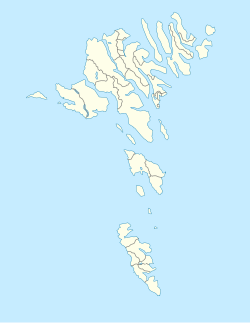Norðragøta
| Norðragøta | |
|---|---|
| Village | |

Norðragøta in October 2004
|
|
| Location in the Faroe Islands | |
| Coordinates: 62°12′3″N 6°44′27″W / 62.20083°N 6.74083°WCoordinates: 62°12′3″N 6°44′27″W / 62.20083°N 6.74083°W | |
| State |
|
| Constituent country |
|
| Island | Eysturoy |
| Municipality | Eysturkommuna |
| Population (1 January 2007) | |
| • Total | 567 |
| Time zone | GMT |
| • Summer (DST) | EST (UTC+1) |
| Postal code | FO 512 |
| Climate | Cfc |
Norðragøta, also just referred to as Gøta (Danish: Nordregøte), is a village on Eysturoy, Faroe Islands.
The municipality of Gøta (Gøtu kommuna) was a municipality until 1 January 2009 when it merged with Leirvík into Eysturkommuna. Gøta consists also of the villages Gøtueiði, Gøtugjógv and Syðrugøta. The village lies on Eysturoy's east coast at the bottom of the inlet Gøtuvík. There is a museum called Gøtu Fornminnisavn with the famous house Blásastova. The wooden church in the centre of the village is from 1833.
Gøta is a place of great importance in the history of the Faroe Islands. One of the key figures in the Icelandic saga, Færeyinga saga, called Tróndur Gøtuskegg lived here. Trondur (also called Tróndur í Gøtu) was a heathen Viking-chief who ruled all of the islands for a period of time. In the saga Tróndur is represented as the "bad guy" while the "good guy" is Sigmundur Brestisson. Sigmundur Christianised the Faroe Islands for the King of Norway.
The most popular pastime in Norðragøta is football. The local football team is Víkingur Gøta, formerly known as GÍ Gøta. They play their home games at the Serpugerði Stadium.
Gøta is home to G! Festival, one of the largest music festivals in the Faroe Islands.
Issued on 5 October 1992, the artist was Jákup Pauli Gregoriussen.
FR 231: Hjá Glyvra Hanusi
FR 232: Húsini hjá Peri
FR 233: Blásastova (today a museum)
...
Wikipedia

